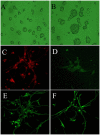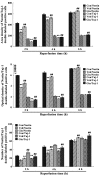In vitro investigation of the mechanism underlying the effect of ginsenoside on the proliferation and differentiation of neural stem cells subjected to oxygen-glucose deprivation/reperfusion
- PMID: 29138802
- PMCID: PMC5746305
- DOI: 10.3892/ijmm.2017.3253
In vitro investigation of the mechanism underlying the effect of ginsenoside on the proliferation and differentiation of neural stem cells subjected to oxygen-glucose deprivation/reperfusion
Abstract
The present study comprised a series of experiments to investigate the mechanism underlying the effect of ginsenoside on the self-renewal, proliferation and differentiation of neural stem cells (NSCs) undergoing oxygen-glucose deprivation/reperfusion (OGD/R) in vitro. The NSCs, which were isolated from the hippocampus of embryonic day 17 embryo rats, were subjected to OGD/R to establish an in vitro model of brain ischemia-reperfusion, following which different doses of ginsenoside were administered to the model. The proliferation of the NSCs was determined using MTT colorimetry and nestin/bromodeoxyuridine (BrdU) immunofluorescent double-labeling. The NSCs were identified by measuring the expression of nestin, and the differentiation of NSCs was assessed through the immunofluorescent double-labeling of nestin/vimentin and nestin/neuron-specific class III β-tubulin (tuj-1). The protein levels of vascular endothelial growth factor (VEGF) and hypoxia-inducible factor-1α (HIF-1α) were detected to investigate the function and mechanism of ginsenoside on ischemic stroke using an enzyme-linked immunosorbent assay. Marked increases in the optical density, area density and numbers of nestin/BrdU-, nestin/vimentin- and nestin/tuj-1-positive cells were found in the ginsenoside-treated group. Compared with the control group, enhanced expression levels of BrdU, tuj-1 and vimentin were found in the ginsenoside-treated group, suggesting that ginsenoside may significantly promote the proliferation and differentiation of NSCs. The results of the present study also showed that ginsenoside significantly increased the protein level of HIF-1α (P<0.05) in the NSCs exposed to OGD/R. These results indicated that ginsenoside may maintain NSC replication, promote NSC proliferation and promote NSC differentiation into neurons and astrocytes. Ginsenoside may initiate the expression of downstream VEGF, which is involved in promoting the survival, self-renewal and differentiation of NSCs.
Figures










Similar articles
-
Effects of Panax notoginseng saponins on proliferation and differentiation of rat hippocampal neural stem cells.Am J Chin Med. 2011;39(5):999-1013. doi: 10.1142/S0192415X11009366. Am J Chin Med. 2011. PMID: 21905288
-
Ketamine interferes with the proliferation and differentiation of neural stem cells in the subventricular zone of neonatal rats.Cell Physiol Biochem. 2015;35(1):315-25. doi: 10.1159/000369698. Epub 2015 Jan 10. Cell Physiol Biochem. 2015. PMID: 25591773
-
Baicalin and ginsenoside Rb1 promote the proliferation and differentiation of neural stem cells in Alzheimer's disease model rats.Brain Res. 2018 Jan 1;1678:187-194. doi: 10.1016/j.brainres.2017.10.003. Epub 2017 Oct 14. Brain Res. 2018. PMID: 29038007
-
A Tale of Two: When Neural Stem Cells Encounter Hypoxia.Cell Mol Neurobiol. 2023 Jul;43(5):1799-1816. doi: 10.1007/s10571-022-01293-6. Epub 2022 Oct 29. Cell Mol Neurobiol. 2023. PMID: 36308642 Free PMC article. Review.
-
Hypoxia in the regulation of neural stem cells.Cell Mol Life Sci. 2011 Sep;68(17):2831-44. doi: 10.1007/s00018-011-0723-5. Epub 2011 May 17. Cell Mol Life Sci. 2011. PMID: 21584807 Free PMC article. Review.
Cited by
-
Artesunate promotes the proliferation of neural stem/progenitor cells and alleviates Ischemia-reperfusion Injury through PI3K/Akt/FOXO-3a/p27kip1 signaling pathway.Aging (Albany NY). 2020 May 7;12(9):8029-8048. doi: 10.18632/aging.103121. Epub 2020 May 7. Aging (Albany NY). 2020. PMID: 32379706 Free PMC article.
-
miR-199a-5p from bone marrow mesenchymal stem cell exosomes promotes the proliferation of neural stem cells by targeting GSK-3β.Acta Biochim Biophys Sin (Shanghai). 2023 May 25;55(5):783-794. doi: 10.3724/abbs.2023024. Acta Biochim Biophys Sin (Shanghai). 2023. PMID: 37232573 Free PMC article.
-
Effects of Tianqijiangtang capsule on survival, self-renewal and differentiation of hippocampal neural stem cells of embryonic rats cultured in high glucose medium.Am J Transl Res. 2019 Sep 15;11(9):5560-5572. eCollection 2019. Am J Transl Res. 2019. PMID: 31632529 Free PMC article.
-
Therapeutic Potential of Chinese Medicine for Endogenous Neurogenesis: A Promising Candidate for Stroke Treatment.Pharmaceuticals (Basel). 2023 May 7;16(5):706. doi: 10.3390/ph16050706. Pharmaceuticals (Basel). 2023. PMID: 37242489 Free PMC article. Review.
-
Ginsenosides reduce body weight and ameliorate hepatic steatosis in high fat diet‑induced obese mice via endoplasmic reticulum stress and p‑STAT3/STAT3 signaling.Mol Med Rep. 2020 Mar;21(3):1059-1070. doi: 10.3892/mmr.2020.10935. Epub 2020 Jan 13. Mol Med Rep. 2020. PMID: 32016448 Free PMC article.
References
-
- Shi Q, Zhang P, Zhang J, Chen X, Lu H, Tian Y, Parker TL, Liu Y. Adenovirus-mediated brain-derived neurotrophic factor expression regulated by hypoxia response element protects brain from injury of transient middle cerebral artery occlusion in mice. Neurosci Lett. 2009;465:220–225. doi: 10.1016/j.neulet.2009.08.049. - DOI - PubMed
MeSH terms
Substances
LinkOut - more resources
Full Text Sources
Other Literature Sources

